Darrell Brooks trial: Defendant apologizes, state calls 7 witnesses
WAUKESHA, Wis. - Witness testimony resumed Monday morning, Oct. 10 in the Darrell Brooks trial, charged in the November 2021 Waukesha Christmas parade attack. Brooks was dressed in a full suit as opposed to the orange jail uniform he wore Wednesday-Friday of the first week of the trial. He remained in the courtroom for the entire day of testimony Monday.
This, after an eventful first week of the trial that saw repeated disruptions from the defendant, prompting him to be moved from the main courtroom every day, starting moments after jury selection began.
As scheduled, Judge Dorow on Monday morning took up the issue of Brooks' witness list. It was determined Brooks' subpoenas would serve as his witness list. There were questions discussed regarding those subpoenas, with Brooks stating he wasn't sure of some of the most recent addresses for some of his witnesses. The state offered to help Brooks find the addresses, and Brooks received some advisement from the judge on filling out those subpoenas.
The state noted the plan as of Monday morning was to wrap their case Thursday afternoon or Friday morning.

Darrell Brooks
The video from Frame Park where Brooks is accused in a fight involving his ex-girlfriend and her roommate that preceded the Waukesha Christmas parade attack was also discussed Monday morning.
The judge said she would be addressing Brooks' concern that he heard his ex, Erika Patterson, make a statement in Waukesha Police Officer Jeremy Philipps' dash camera video about how Brooks ran her over with a car, which he's charged with doing in Milwaukee County. That prior incident was prohibited from being discussed in court during the Waukesha parade trial. The state said they could redact a few seconds of the video, and if the jury asked to see it again, they would be prevented from hearing that a second time.
"I can only hear out of one ear, and I could hear clearly what was said," said Brooks. "You made the ruling. I see no reason why the exhibit should be admitted into evidence. It was obvious what was being referenced."
Judge Dorow agreed with Brooks, saying she gave a very clear ruling in regard to other acts being discussed during this trial. She noted a redaction could actually highlight that portion of the video for the jury.

Prosecution team in Darrell Brooks trial
The judge also made note of a report filed last week after Brooks claimed he was injured while being moved between courtrooms following his repeated disruptive behavior.
The state asked to release witnesses that testified during the first week of trial: Kori Runkel, Erika Patterson, Steven Guth, Jeremy Philipps, Kyle Edwards and Holly Berg.
It was noted that Patterson and Guth were on Brooks' witness list. Philipps remained under subpoena Monday along with Guth and Patterson.
Brooks' apology to court
Before the jury was brought into the courtroom, Brooks apologized to the court and everyone involved in the proceedings for his actions during the first week of the trial.
"I just want to state this for the record that I would like to issue the court an apology from me in regards to my actions last week during the trial," Brooks said. "I just want the court to understand it's very emotional right now, not only for just the whole situation of the trial, the families here that have to go through, you know, everything that's going to be involved with the trial, but also my family, as well, myself. It's very, very emotional but not to excuse my actions, and I should carry myself with better respect. I wasn't raised that way, and I owe you, your Honor, and the court an apology."
Brooks went on to say, "And I want to stand up as a man and tell the whole court and you, your Honor, I want to apologize to the bailiffs that I want to apologize for my actions. Like I said, that's not how I was raised. I come from a Christian background. My mother did not raise me that way. She did not raise me to act out out of frustration and irritation and anger, and I just wanted everyone to know that I apologize for my actions and I'm going to try my best to, whatever happens, to conduct myself with respect and with respect to the court, and I just wanted you all to know that. The prosecution, the judge, bailiffs, clerks, reporters, everybody, audience, everybody here. I just wanted you all to know that."
On Monday, Brooks continued to make his "sovereign citizen" arguments. After his apology, he again raised the issue of "subject matter jurisdiction," asking that it be addressed by the court. Brooks later brought up several court cases regarding subject matter jurisdiction, and Judge Dorow said she would look at those cases and take this issue under advisement. However, she did note that she had previously addressed this matter, "and my previous rulings stand."
Darrell Brooks trial: Is there a motive behind his change in demeanor?
On Monday, Oct. 10, there seemed to be a significant change in demeanor by Darrell Brooks in his trial. He was dressed in street clothes, his line of questioning was measured, and there was an apology. What is behind it? We get an attorney's perspective.
Brooks' trial timeline: Monday, Oct. 10
Below is a timeline of events in court Monday, per court records:
8:30 a.m.: Case called for Day 6 of jury trial
Brooks was wearing a suit and tie
Brooks would remain in the main courtroom the entire day; he was removed each day during the first week of trial due to repeated disruptions
Brooks had subpoenas the state offered to serve on his behalf -- discussion about Brooks' subpoenas
Video introduced by the state was stricken from the record due to comments from Erika Patterson, Brooks' ex, regarding a prior case -- not allowed during this trial
9:02 a.m.: Jury entered
Brooks cross-examined Detective Casey, who testified Friday
Officer Bryce Butryn was called by the state
Brooks cross-examined Butryn
Morning break
10:42 a.m.: Jury re-entered after morning break
Officer Sonia Schneider was called by the state
Brooks cross-examined Schneider
District Attorney Sue Opper re-directed the witness
Brooks re-crossed the witness
11:35 a.m.: Lunch recess
12:35 p.m.: Court back on the record
State raised concerns regarding Brooks' subpoenas -- another discussion about Brooks' subpoenas, also set to serve as his witness list
State advised one of the witnesses Brooks subpoenaed (a parade organizer) had moved to Texas and would not be served
State objected to three witnesses on Brooks' list (Kori Runkel, Erika Patterson, and Steven Guth) -- all three previously testified for the state
Judge ruled she would accept these witnesses if the proper subpoenas were submitted by Brooks by the end of the day Monday
12:59 p.m.: Jury re-entered
Battalion Chief Jim Haakenson called by the state
Assistant District Attorney Zachary Wittchow questioned Haakenson
Brooks cross-examined Haakenson
Wittchow re-directed Haakensonn
Nicole White, whom prosecutors say was the first person hit by Brooks, was called by the state
Deputy District Attorney Leslie Boese questioned White
Brooks cross-examined White
Boese re-directed White
Sarah Wehmeier-Aparicio, Waukesha South High School band director in November 2021, was called by the state
Wittchow questioned Wehmeier-Aparicio
Brief recess -- Brooks given new subpoena forms
2:58 p.m.: Jury re-entered
Brooks cross-examined Wehmeier-Aparicio
Wittchow re-directed Wehmeier-Aparicio
Kyle Jewell, who was at the parade with his family, was called by the state
Opper questioned Jewell
Brooks cross-examined Jewell
Opper re-directed Jewell
Break to discuss witness Thomas Greene's prior conviction for misdemeanor criminal trespass
Judge ruled limited questioning regarding Greene's conviction would be allowed
4:16 p.m.: Jury re-entered
Thomas Greene, who was at the parade with his family, was called by the state
Wittchow questioned Greene
Brooks cross-examined Greene
Wittchow re-directed Greene
4:56 p.m.: Judge Dorow read instructions to the jury, and they were dismissed
5 p.m.: Court in recess
Detective Thomas Casey cross-examined
First up on the stand Monday morning was Waukesha Police Detective Thomas Casey. He was there to be cross-examined by Brooks as to his testimony Friday.

Waukesha Police Detective Thomas Casey
Casey was asked by Brooks about his description of the driver of the SUV.
"Do you recall what they were wearing?" asked Brooks.
"No, I do not," said Casey.
"So you could get a description of the person but not what they were wearing?" asked Brooks.
"Yes," said Casey.
Brooks also asked Casey whether he saw the vehicle strike anyone, and Casey said no.
"Fair to say there were hundreds of people around? And you didn’t see anyone be struck?" asked Brooks.

Photo shown in court Friday, Oct. 7 allegedly showing Darrell Brooks driving the red Ford Escape
"No, I did not," said Casey.
Casey was also asked whether he was a party to this case, whether he had a claim in this case and whether the state of Wisconsin was in court – Brooks' "sovereign citizen" arguments.
"Yes, I do," said Casey. He said the state of Wisconsin was being represented by the three prosecutors.
"An entity is an entity – not a human being," said Casey.
Casey was asked about the fact that he heard the SUV's horn blowing.
"Would you say that was trying to indicate people to its presence?" asked Brooks.
The state's objection was sustained by the judge.
Brooks asked Casey if he was hurt trying to stop the vehicle.
"I was not injured," said Casey.
Casey was shown a photo prosecutors say shows Brooks behind the wheel. Casey said the vehicle "never stopped" as it went past him at White Rock and Main.
Waukesha Police Officer Bryce Butryn testifies
Waukesha Police Officer Bryce Butryn took the stand for the state following Detective Casey. He offered his own description of the events that unfolded at the Waukesha Christmas Parade – about a car in the parade route.
Butryn talked about the initial call for a fight involving a knife at Frame Park. He then talked about coming into contact with the red SUV.
"The vehicle was on Main, honking its horn and traveling 25 mph," said Butryn.
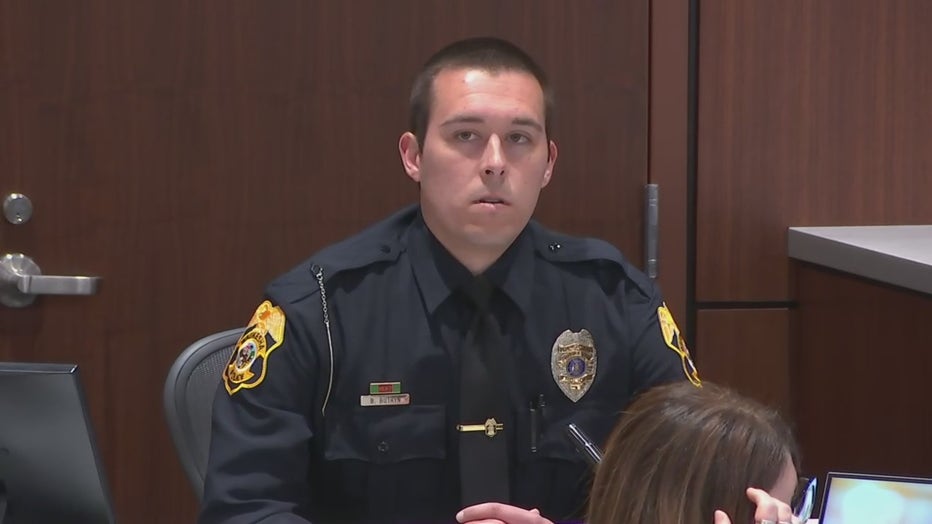
Waukesha Police Officer Bryce Butryn
"What did you do?" asked Opper.
"I raised my hand to try to get the vehicle to stop," said Butryn.
He said he thought he was going to be hit, so he moved out of the way. He said he would say he got a good look at the driver's face and did not see anyone else inside. He said he heard the SUV's horn honking multiple times.
The officer said after the vehicle passed him, he saw "items flying into the air."
"There was so many things flying, I don’t know what was being struck," said Butryn.

Waukesha Police Officer Bryce Butryn
He said after people were hit, the driver did not stop the check on people.
Afterward, Butryn noted that "there were multiple casualties on both sides of the road. Varying injuries. Chaos. People pulling at me needing help."
Butryn said he was present where the SUV was later found and discussed a hat found on the ground. A picture was shown.
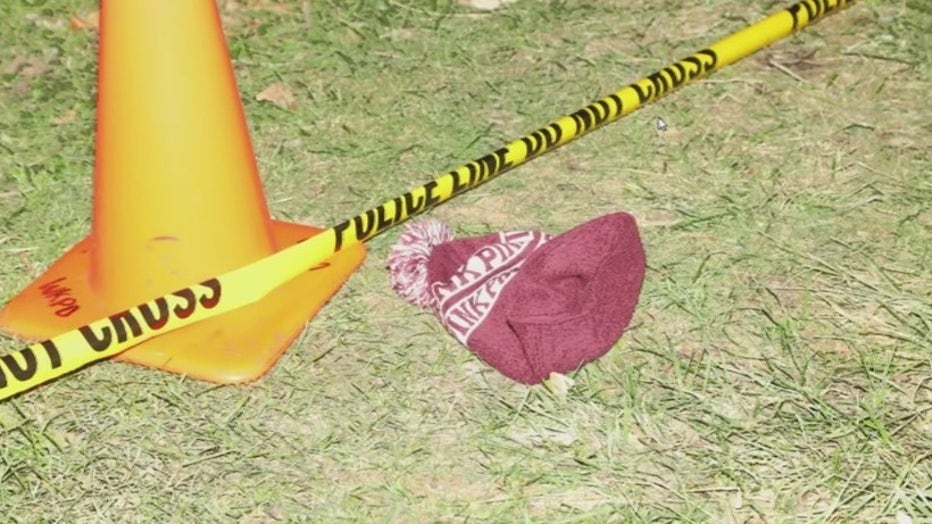
Hat found near where red SUV was recovered after Christmas parade attack
During cross-examination, Brooks asked Butryn whether he saw the vehicle hit anyone, and Butryn said no. He said he was not injured in the incident.
Brooks asked Butryn repeatedly whether he heard the vehicle honking, and video was replayed for Butryn.
Waukesha Police Officer Sonia Schneider testifies
Waukesha Police Officer Sonia Schneider, who had been working near Officer Butryn, took the stand after the morning recess, sharing her version of the events that unfolded during the Waukesha Christmas Parade. Schneider identified Brooks in court as the driver of the red SUV that was seen on the Waukesha Christmas Parade route.
"I heard radio traffic about a vehicle going through barricades," she said. "I ran forward to also try and stop the vehicle."

Waukesha Police Officer Sonia Schneider
Schneider testified that the SUV's driver had time to slow down and turn off the parade route onto Buckley.
"I tried to direct the vehicle off to Buckley," said Schneider. "I stood directly in the path of the SUV."
"Did you say anything or gesture to the vehicle?" asked Opper.
"I tried to get the driver to observe me in the street," said Schneider, adding that she had to "jump out of the way."
She described the driver as an "African American male with brown eyes and brown hair."
"He had no expression – looking straight ahead like he was looking straight through me," said Schneider.
Schneider said she never heard the SUV's horn.
Afterward, Schneider said she was "stopped by many people who had kids hit." One of them was Jessalyn Torres, a member of the Waukesha Xtreme Dance Team. She said Jessalyn's injuries were significant.
Schneider said she was then asked to stand guard over one of the deceased -- a member of the Milwaukee Dancing Grannies.
On cross-examination, Brooks asked Schneider whether she was next to Officer Butryn at the time, and she said yes.

Waukesha Police Officer Sonia Schneider
"Any reason you couldn’t hear the same things he did?" asked Brooks. The state objected.
Brooks asked Schneider whether the driver of the SUV could have made a turn off the parade route onto a barricaded street. She said the barricade could have been moved.
"I saw the vehicle coming from the White Rock location; we often have people disregard police barricades," said Schneider.
The video was replayed for Schneider, and she said she did not hear a horn.
"I don’t have any information about honking," said Schneider.
Brooks then asked Schneider who subpoenaed her to testify Monday, and she said the state.
"Are you aware all police departments are funded by the state of Wisconsin?" asked Brooks. The state objected.
Schneider was asked whether she saw the vehicle try to strike anyone. She said the vehicle did not deviate.
"It was driving in a straight line," she said.

Darrell Brooks in court Monday, Oct. 10
On redirect, Opper asked Brooks if she saw the driver of the red SUV in the courtroom, she said, "Yes, I do." Brooks was asked to remove his mask for identification.
Brooks then asked Schneider whether she could see his eye color from her position on the witness stand. She previously testified that the driver had brown hair and brown eyes.
Schneider said she could not see Brooks' eye color in court Monday.
Brooks' subpoenas/witness list discussed
Court broke for a lunch recess around 11:30 a.m. and resumed around 12:35 p.m. with some procedural work.
After lunch, it was noted that Brooks did not fill out his subpoenas correctly, specifically, the portion relating to the "caption," which lays out the case (i.e. State of Wisconsin vs. Darrell E. Brooks). His subpoenas also requested witnesses bring police reports/documentation with them. It was noted that witnesses are not custodians of the record.
Brooks explained that he's never filled subpoenas out before and had stated he needs assistance to ensure they were filled out correctly.
Judge Dorow said the documentation Brooks was seeking would be in his discovery materials and that he would have time before the end of Monday to redo his subpoenas.
During this discussion, it was noted by the prosecution that one of the witnesses Brooks sought to call, a parade organizer, had relocated to Texas. The state had previously offered to assist Brooks in serving his subpoenas as long as the witnesses live in Wisconsin, saying he would have to arrange transportation for this Texas witness. Brooks told the court, "I'm broke," and he asked how he would be able to arrange this transportation.
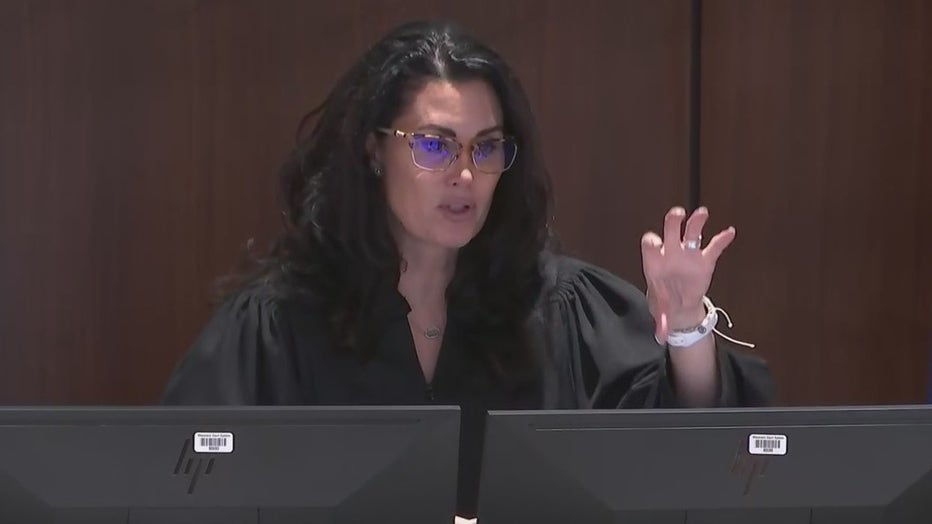
Judge Jennifer Dorow
Another of Brooks' witnesses was also discussed, the parent of a victim in the parade attack. The state noted she was not present at the actual parade and wanted to know what type of testimony he sought from her.
It was also noted that some of the witnesses on Brooks' list (Erika Patterson, for example) had previously testified. Judge Dorow noted that Brooks had an opportunity already to cross-examine these witnesses but said she was giving him some "leeway" since he is a "pro se defendant" (representing himself).
The judge kept the witnesses who previously testified on Brooks' witness list along with the parent of the parade victim.
At this point, before the jury returned after lunch, was when Brooks brought up subject matter jurisdiction and cited the cases related to this issue. Judge Dorow said she would be looking at the cases, adding that she did not "believe it will change her ruling that (Brooks') challenge issues are without merit."
Waukesha Fire Department Battalion Chief Jim Haakenson testifies
First on the witness stand after the lunch break was Waukesha Fire Dept Battalion Chief Jim Haakenson. He testified about initial reports of what was happening along the parade route in Waukesha, what he personally saw and how Waukesha firefighters were helping numerous victims.
"Initially, it was an unknown problem," he said. "Based on traffic, we heard it was vehicle vs. person."
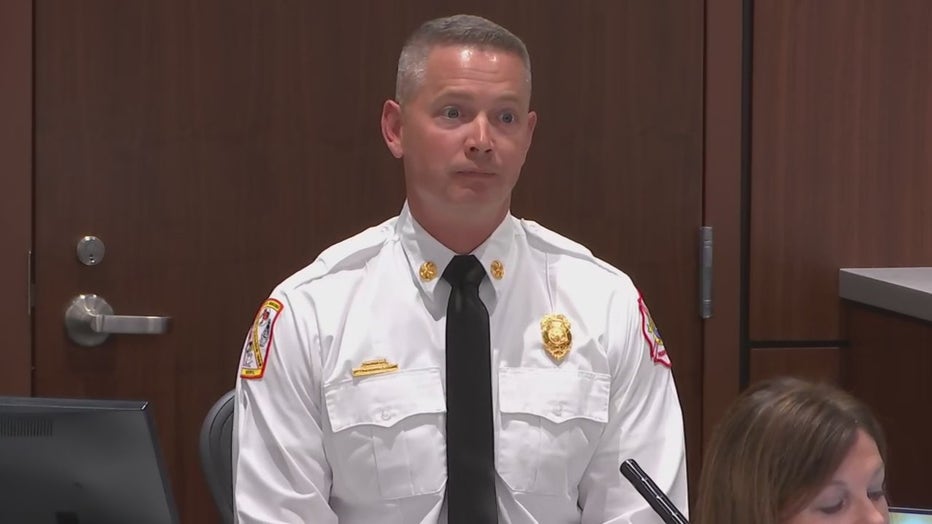
Waukesha Fire Dept Battalion Chief Jim Haakenson
Haakenson noted the response was difficult because so many people were trying to flee the parade.
Brooks questioned Haakenson about a loss of power to the area that night, and Haakenson said it was later determined that a power line went down, knocking out power to downtown Waukesha and this had nothing to do with the parade attack incident.
Nicole White, 1st person hit by SUV, testifies
Nicole White, who walked with the RE/MAX group in the Waukesha Christmas Parade, was next to testify for the state in the Brooks trial. Prosecutors say White was the first person struck by Brooks along the parade route.
White said she didn't know anything was wrong that day until she was hit.
"When I looked up, the vehicle just continued," she said.
She said she didn't see brake lights and did not hear a horn.
After she was hit, White said she was taken into the Smart Asset Realty building before being taken to Waukesha Memorial Hospital. She suffered injuries to her knee and spine/tailbone.
She said she did not get a license plate number for the SUV.

Nicole White
Brooks questioned White about her police report in which she said he heard screaming and looked around before she was hit.
"Do you recall saying that?" asked Brooks.
"I do not recall those exact words, no," said White.
As Brooks read from the police report, White appeared to be nervously shaking and uncomfortable on the stand.
Sarah Wehmeier-Aparicio, Waukesha South band director, testifies
Next on the stand Monday afternoon was Sarah Wehmeier-Aparicio, Waukesha South High School's band director in November 2021.
Wehmeier-Aparicio testified she was at the front of the band when the incident occurred.
"All the sudden, I thought I heard something... there was some sort of vehicle trying to get through," she said.
She said she then saw things "flying through the air."
Wehmeier-Aparicio said she initially thought it was an accident.
"But as the driver went past, I saw he was staring straight ahead," she said.

Waukesha South High School band
Ten members of the Waukesha South band were hit near the gelato shop. Video was played in which band noise turned to screaming.
"There were many broken bones, internal bleeding, dental work, stitches, sprains…" she said.
She estimated she was "probably two feet" from the SUV.
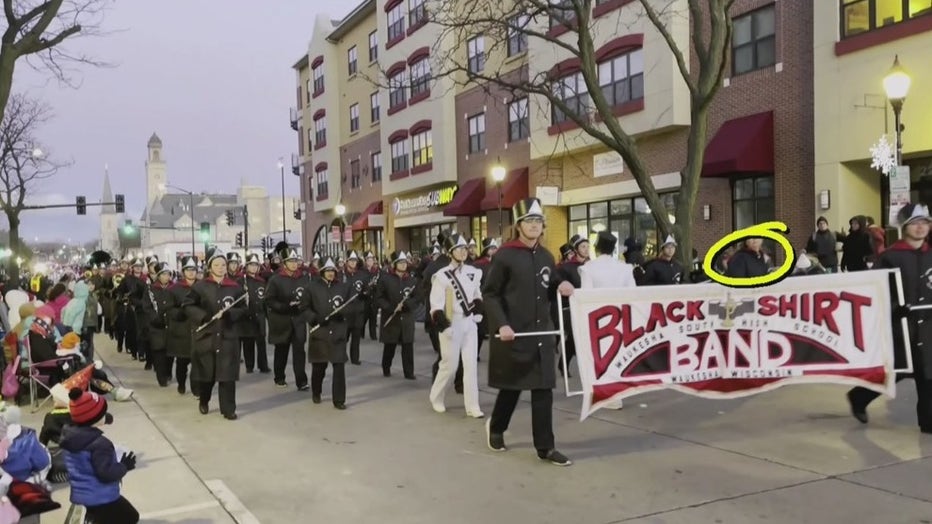
Sarah Wehmeier-Aparicio, Waukesha South band director in November 2021
The court took an afternoon recess before cross-examination of Wehmeier-Aparicio.
On cross-examination, Brooks asked Wehmeier-Aparicio whether she was injured.
"I was not. Fortunately, I moved just in time," she said.
He also asked whether anyone next to her was injured and whether she was able to get a license plate number. She said no. She said she did not see anyone else in the SUV besides the driver.
Brooks asked if she heard any sounds before she realized something was wrong.
"The band had just started playing, so I was concentrated on just the sounds of the band. Then all of a sudden, it was just the sounds of chaos as the car started to come through…" she said.
She was asked whether the sound of the band would have impaired her ability to hear, say, the sound of a car horn.
Wehmeier-Aparicio answered that she believes she would have been able to hear a car horn, telling Brooks it would have been "an unexpected sound."
"As soon as the screaming started, we did hear that immediately, because as soon as the screaming started, the students stopped playing," she said.
Brooks asked whether she was walking forward or backward, and she said she was walking forwards because the students were walking backward and she was "the eyes in front of the students walking backward." Brooks then questioned her on whether the police report misquoted her. She said, "I have not seen the report."
Wehmeier-Aparicio was asked whether she thought the SUV was "driving right at you."
"It felt like it right for a moment, yes," she said.
She said she briefly ran after the SUV.
"That was my instinct at the moment," she said.

Darrell Brooks in court Monday, Oct. 10
"Would it be fair to say the unexpectedness of the event may have clouded everything that you recall about it?" asked Brooks.
"There are certain aspects of the event that I have great clarity for because it was such a life-changing thing," she said. "Maybe 11 months later aspects are not as clear because some of the other graphic details are so clear in my mind."
She said it would be "accurate" to say she doesn't remember everything from that evening but said "no" when asked if she would have left out any details in her police report.
Brooks asked about news reports that Wehmeier-Aparicio said she saw, asking if they jogged her memory. She said not especially and said "yes" when asked if she already knew what was reported in the news. She was asked whether the news reports were accurate, and an objection from the state was sustained.
On redirect, ADA Wittchow had the band director clarify that she did not type out her police report but provided interviews to the police who wrote the reports.
Wittchow then moved to play a video for her and Brooks objected, saying it had been seen multiple times at that point. Wittchow said she was asked if she heard a horn.
"I simply want to play this video to see if the witness can hear the sound of a horn," said Wittchow.
Brooks’ objection was sustained.
Kyle Jewell, Waukesha Christmas Parade attendee, testifies
Next up for the state was Kyle Jewell, who attended the parade with family.

Kyle Jewell
Jewell said he was near new apartments and a chocolate shop right on Main Street.
"We were watching the parade, had a bunch of kids in front of us," he said. "At one point, we had, I believe, the ReMax hot air balloon truck coming to the left of us. We started hearing some people yelling, ‘Stop that car!’ It just drove right through the Waukesha South band and just kept going."
He said it was a red SUV that "went straight over the Waukesha South band."
"I saw what looked like it went in the air over a pretty big object… It just looked like a big speed bump and kept going," said Jewell.
He said his reaction was to "go after it," but he wasn't fast enough.

Kyle Jewell with family at the Waukesha Christmas parade -- noted by the yellow line
"It drove off at a pretty good rate of speed," he said.
Jewell said he didn't hear the horn. The vehicle didn't stop.
Opper asked Jewell what he was thinking at this point.
"Really, what’s going on? Normally, you don’t see a vehicle going that quick down a parade route," he said.
Jewell said he ran after the SUV for a pretty good distance, but he was not able to catch up to it. As he made his way back to his family, he came upon injured people, mostly from the Waukesha South band.
On cross-examination, Brooks asked whether Jewell recalled being interviewed by a Detective Carpenter and "why it took a few days." Jewell answered that it was "probably due to the nature of the incident," adding that it wasn't something he was going to do. Brooks asked him to clarify, and he said he wasn't going to file a report as he didn't feel comfortable. Brooks asked if it was fair to say that the events that transpired would make anyone want to make a report, and he said yes.
Brooks asked whether Jewell or his family members were injured, and he said no.
Looking at the police report, Brooks asked Jewell to confirm he did not get a description of the driver, and he said he did not. He also did not get a license plate number. He said the back windows were tinted, and he could not see into the back of the vehicle. Jewell said "yes" when asked if he knew how many people were in the vehicle and "yes" when asked if that was true even though he couldn't see the entire inside of the vehicle.
Brooks questioned Jewell about his police report, asking whether he recalled saying he was "within an arm's reach" of the SUV. Jewell said "no," and Brooks asked why. Jewell said there was a lot happening. He said, "I cannot recall right now" being in arm's length of the SUV.

Darrell Brooks in court Monday, Oct. 10
Jewell was asked when the vehicle slowed down, and he said that was after it went over the band. After that, it sped up, he said. He answered "yes" when asked if he would describe that as a "rapid acceleration."
"The nature of the vehicle going over people… I could only imagine that the gas pedal was being pushed very hard after just going over people," said Jewell.
Brooks asked if that was an assumption. He said from what he remembers, it looked like the gas pedal was being hit hard.
Jewell said after hitting the band, the SUV continued down the parade route. He said he did not recall how far. He said he did not see any brake lights, even when the vehicle slowed down when hitting the band.
"Hitting something or going over something will naturally slow a vehicle down," Jewell said.
Brooks had video played for Jewell and asked whether he heard a horn. Jewell said he did not. Brooks then asked if other noise would have impaired his hearing in any way, and Jewell said "no." Brooks asked if it was possible there was a horn he didn't hear.
"No. Horns are pretty loud. It would have been heard," said Jewell.
Brooks asked what the driver was doing, and Jewell said "driving the car," focused on the road ahead.
"I could tell there was one person in the car. I could see that they were wearing some sort of hat or sweatshirt. That was about it," he said.
Jewell was asked whether he tried to help any of the people who were injured.
"At that point, when I started running back, there were a lot of bodies on the ground," said Jewell.

Kyle Jewell
He said it seemed like there were people helping the victims, so his "next instinct" was to find his family. Brooks followed up by asking, "So you didn't stop to help anyone?" An objection from the state was sustained.
Brooks then asked Jewell if he heard any news reports about the event, and he noted that his family doesn't watch TV too much and that "there was a lot of emotional stuff we were just working through." Brooks followed up by asking if he saw any mugshot or photos of the suspected driver or the name of the suspect. He said he did not see photos but did hear the name "at some point in time."
Brooks then asked Jewell about the video shown in court, which he said he viewed Monday for the second time. Brooks asked whether it jogged his memory as to anything he may not have remembered at the time of his police report. Jewell said "no."
Brooks then asked Jewell who he was contacted by about being a witness in this trial. He asked Jewell if he knew the plaintiff or read the complaint. Objections were sustained.
Jewell was then asked whether anyone seated near him on the curb was hit, and he said "no."
"In your opinion, after observing people struck, in your opinion, how did the vehicle miss people that were directly in front of you?" asked Brooks. An objection was sustained.
Jewell said the only people he saw struck were members of the band.
"Fair to say there were hundreds, even thousands of people for the parade?" asked Brooks.
"Yes," said Jewell.
"And you only saw a handful of people struck?" said Brooks.
"Waukesha South Band is a pretty large band, and the red SUV went right through it and if I had to estimate, 10, maybe 15, I don't know the exact number, were struck by the SUV," said Jewell.
"Fair to say that’s a small portion of people struck…" said Brooks. An objection was sustained.
On redirect, Opper asked for the video shown to Jewell to be replayed. She asked if she heard the SUV's horn, and he said no.
Witness' conviction discussed
The jury was dismissed for a discussion about the next witness, Thomas Greene, who has a prior conviction from 2005 for misdemeanor criminal trespass. ADA Wittchow noted this was 17 years ago, and the witness was 21 at the time and is now 38. Wittchow said there had been no other convictions, and the state did not believe the trespass conviction was relevant and should be excluded for the purpose of his testimony.
Brooks noted his own criminal record, dating back to 1999.
"If I was going to take the stand, my record would be brought up, and some things on my record was done 20-something years ago… but it would still have bearing, so I believe it should be fair," he said. "It should be the same. I believe that if the witness knew that it was a possibility that they would give testimony and agree to give testimony, then they also agree that their credibility can be questioned."
The judge advised the inquiry would be limited to the following: "Have been convicted of a crime," and if so, "How many times?"
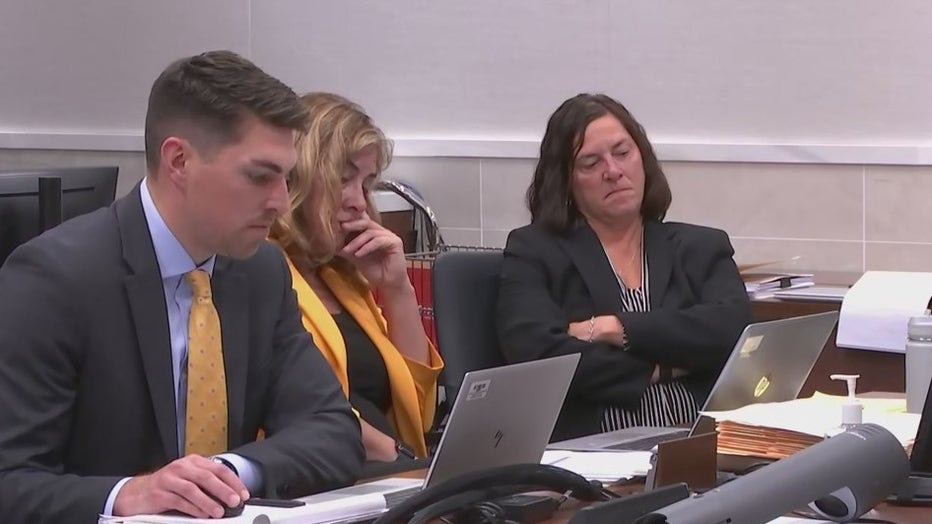
Prosecution in court on Monday, Oct. 10
Wittchow noted the nature of the crime, entry into a locked building or construction site and again noted no further convictions.
The judge ruled there could be questioning regarding the prior conviction, though limited.
"We’re not going to spend a lot of time on that. That’s going to be my caveat on all of this," said Judge Dorow.
Thomas Greene, Waukesha Christmas parade attendee, testifies
After the jury was brought back in, the state called Thomas Greene, who attended the parade with his family Nov. 21, 2021.

Thomas Greene
"We were just watching the Christmas Parade as we normally do. Go to a lot of parades as a family," said Greene. "I heard a loud crash noise to my right. I looked that way. I seen a car running over the marching band, and as soon as the car had run over the marching band, it swerved towards me and my family and then proceeded down the parade route."

Thomas Greene
He said he and his wife and three children were facing the parade straight on; his children in front of him.
Greene was shown two videos. Greene said the first "shows where the SUV had run over the band, where I first heard it coming, and then it swerved over towards my family," and the second "looks like the SUV right after it ran into my kids."
Greene was asked if his kids were struck by the vehicle, and he said, "Yes, they were."
Brooks' second question to Greene on cross was whether he has been convicted of a crime.
Greene was then asked what he did after the vehicle passed him.
"I ran to my kids to see if they were OK," said Greene.
Brooks asked Greene if he saw the driver of the SUV.
"I seen someone in a hoodie with dark skin," said Greene, adding that he did not see anyone else in the vehicle and that the back windows were tinted. He said he didn't get a license plate number. He said it was "hard to say" how fast the SUV was going. He said he didn't see the vehicle strike anyone else. He said he and his wife weren't hurt.
Brooks then asked Greene about whether he filed a police report, and Greene said "not at the incident" but he did days later.
Greene testified that when he initially saw the red SUV, he thought it was part of the parade.
Brooks questioned Greene on his statement that the driver was "tan-skinned" as opposed to his prior testimony Monday that the driver was "dark-skinned."
"From your perspective, dark skin and tan skin are the same?" asked Brooks. An objection from the state was sustained.
Brooks asked Greene what he would consider dark skin.
"Hard to say," said Greene.
"What do you consider to be tan-skinned?" asked Brooks.
"Darker than Caucasian, I guess," said Greene.
"Fair to say that there is different type of shades or colors of people?" asked Brooks.
"Yes," said Greene.

Thomas Greene
Brooks then asked Greene if he heard gunshots, and Greene said no. Brooks followed up by asking why that would be in the police report. An objection from the state was sustained. Greene clarified that he recalled an officer coming down the street yelling shots fired.
Brooks questioned Greene about when he left the parade. Greene responded that it was after they checked to make sure their kids were OK, and an officer came running down the street saying, "Shots fired."
"Would it be fair to say you were prompted to leave because of the shots fired and not because of the incident that happened at the parade?" said Brooks.
"I don’t understand what you’re asking," said Greene.
"What prompted you to leave?" asked Brooks.
"When the officer said shots fired," said Greene.
"So not because of the incident…" said Brooks.
"We did not want to leave right away because my son said he could not feel his legs, and there was a woman there who said we should not move him," said Greene.
"Did you try to make a call for medical attention at that point?" asked Brooks.
"I did not," said Greene. "This all happened within about a two-second timeframe. It was so fast. It was chaotic. There really wasn’t time to do anything besides to check if my kids were OK."
On redirect, Wittchow asked if Greene continued to believe this was an accident after having that initial thought.
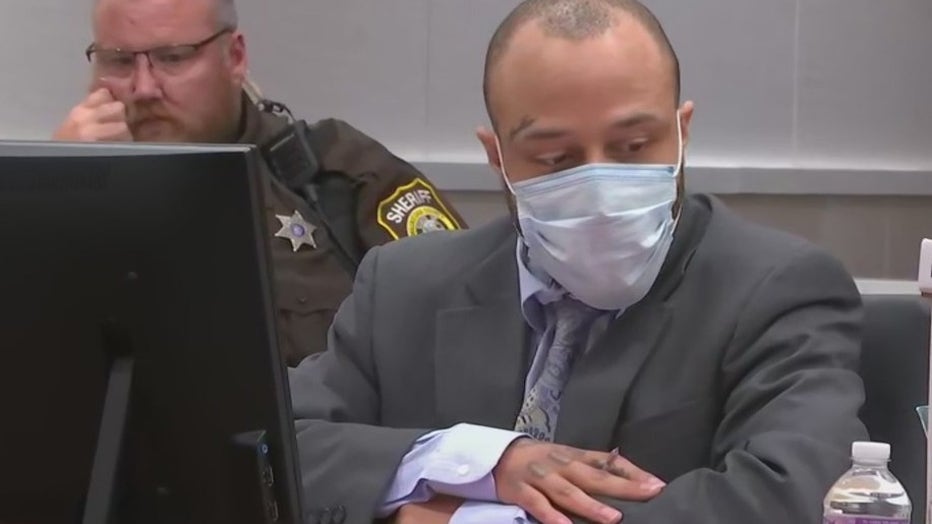
Darrell Brooks in court Monday, Oct. 10
"Once the vehicle kept going after hitting the band, I realized that it was not part of the parade," said Greene.
Wittchow asked what led to that realization.
"The speed at which it accelerated," said Greene.
Greene described his children's injuries.
"My son had nerve damage to his knees, and my daughter had bruising," said Greene. "My son was struck in the knees, and my daughter was struck in the hand."
The judge gave jury instructions, and the jury was dismissed for the day around 5 p.m.
Before the court recessed for the night, the state brought up Brooks' subject matter jurisdiction objection and the cases he reference earlier Monday. Judge Dorow said she would address this Tuesday morning, saying, "Frankly, I need time to read (the cases)."
Brooks then asked more questions about his subpoenas, seeking clarification on whether he needed to fill out the portion that asks whether the witnesses need to bring anything with them for their testimony. The judge advised that Brooks should have all of the police reports/documentation in his boxes, but if there was something else he needed, he would need to subpoena the custodian of the police records or ask the state about what he was seeking. He was advised he can leave the portion of the form blank if he's simply requesting their testimony.
The court recessed shortly after 5 p.m.
Christmas parade attack
Prosecutors say Brooks drove a red SUV through the parade route on Nov. 21, 2021, killing six and injuring more than 60 others.
On Nov. 21, 2021, according to prosecutors, Brooks met up with his ex-girlfriend in Frame Park, the same woman he is accused of running over with his red SUV earlier in November 2021. She told police they argued in his SUV before he started driving, and he "was driving around with one hand and striking her in the face with his other hand." She eventually got out and called her friends for help.
Soon after that, according to prosecutors, Brooks drove that red SUV through the parade route, killing Jackson Sparks, 8, Virginia Sorenson, 79, LeAnna Owen, 71, Tamara Durand, 52, Jane Kulich, 52 and Wilhelm Hospel, 81. More than 60 others were hurt.

Waukesha parade attack victims identified
Brooks was arrested the night of the attack, soon after telling a Waukesha resident that he was homeless and waiting for an Uber. The man was unaware of the events that had occurred and let Brooks into his home.
FREE DOWNLOAD: Get breaking news alerts in the FOX6 News app for iOS or Android
Brooks entered an insanity plea in June after initially pleading not guilty to the charges in February, a move that could have resulted in him being sentenced to a mental institution rather than prison if convicted. He later dropped the insanity plea on Sept. 9.
Darrell Brooks faces 76 charges, including six counts of first-degree intentional homicide and 61 counts of reckless endangerment. Each homicide charge carries a mandatory life sentence.

